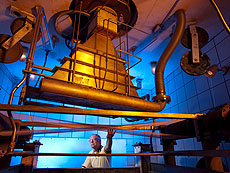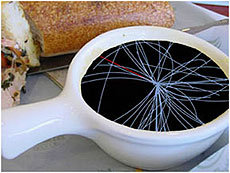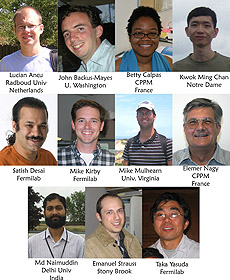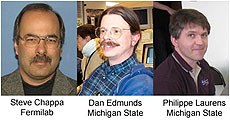|
Thursday, Sept. 2
- Breakfast: Apple sticks
- Tomato Florentine
- Barbecue pork sandwich
- Smart cuisine: kielbasa & sauercraut
- Smart cuisine: Chicken Marsala
- Smoked turkey melt
- Assorted sliced pizza
- Southwest chicken salad w/ roasted corn salsa
Wilson Hall Cafe Menu
|
|
Thursday, Sept. 2
Dinner
Closed
Wednesday, Sept. 8
Lunch
- Sesame-chile chicken w/ gingered watermelon salsa
- Basmati rice
- Coconut flan
Chez Leon Menu
Call x3524 to make your reservation.
|
|
|
DUSEL meeting starts today
The first meeting of the DUSEL users' organization will start today at 1 p.m. in One West. The agenda and registration information are available on the DuRA meeting website. Those who cannot attend in person can watch the meeting streamed live.
|
Accelerators for America's future
 |
| In this Illinois plant, a beam of accelerated electrons makes polymer coatings for wire and cable more heat resistant. |
Editor's note: The new issue of symmetry, now available online, includes an excerpt of the report Accelerators for America's Future, published by the DOE Office of Science. The full report can be downloaded as a pdf file, and hard copies can be requested at www.acceleratorsamerica.org.
A beam of particles is a very useful tool.
A beam of the right particles with the right energy at the right intensity can shrink a tumor, produce cleaner energy, spot suspicious cargo, make a better radial tire, clean up dirty drinking water, map a protein, study a nuclear explosion, design a new drug, make a heat-resistant automotive cable, diagnose a disease, reduce nuclear waste, detect an art forgery, implant ions in a semiconductor, prospect for oil, date an archaeological find, package a Thanksgiving turkey, or discover the secrets of the universe.
The beams produced by today's particle accelerators address many of the challenges confronting our nation in the 21st century: energy, the environment, good jobs and economic security, health care, national defense, and the war on terror.
Read more
|
Particle physics and America's future
From symmetry, Aug. 2010
 |
|
Dennis Kovar
|
|
These are extraordinary times for particle physics, remarkable not only for the scientific discoveries that could be in store, but also for the very real opportunities to address critical issues confronting our nation.
We are in the midst of a revolution in the understanding of the very small and the very large. For decades and more, we have been talking about discoveries that may await us when we reach the ultra-high energies of the Terascale. Now we are there. As Fermilab's Tevatron culminates its performance with record luminosities and the Large Hadron Collider begins operations, we have the possibility for discoveries such as extra dimensions and supersymmetry that could fundamentally change our perspective on the universe. If we are fortunate, over the next decade or so we could be in a position to rewrite the textbooks.
We also recognize that future advances will require a new generation of technologies. The detectors and accelerators of tomorrow will need more sensitivity and higher energies, and they must cost less. The quest to develop the tools for future discovery is scarcely less challenging and exciting than the quest for the discoveries themselves.
Read more
|
Banana spider
 |
John Sachtschale of Technical Division's Design Drafting Group took this photo of a banana spider outside of Trailer 157 on Sept. 1. |
|
Panel throws Tevatron a lifeline
From Nature, Sept. 1, 2010
A Fermilab advisory committee has released a report recommending that the Tevatron's operations be extended until 2014, at a cost of around $150 million. The Tevatron is a proton-anti-proton collider that produced the discovery of the top quark and that has placed constraints on the mass of the Higgs, the elusive particle hypothesized to endow others with mass.
Keith Baker of Yale University, a member of the committee, says the primary reason for recommending an extension was the likelihood that an extended Tevatron run would find a signal of the Higgs at the statistical level of 3 standard deviations--the level needed to claim evidence, although not proof, in the particle physics community. The extension would more than double the luminosity of the colliding beam, greatly increasing the number of particle collisions that are produced. Even if no Higgs is seen, the resulting data would be enough to bring the Higgs no-show into direct conflict with observed masses for know particles such as the top quark--something that particle physicists find as tantalizing as the possibility of an actual detection. "That is an indication of new physics" says Baker.
Read more
|
Researchers devise the first experimental test of controversial, confusing string theory
From PopSci, Sept. 1, 2010
Is everything in the universe made up of vibrating one-dimensional strings? For the first time, scientists think they can concretely test string theory, the mind-blowing "theory of everything" that has dominated physics for the past two decades. It turns out that string theory predicts the behavior of entangled quantum particles, which can be tested in a lab - therefore testing string theory.
Read more
|
|
|
An ingredient for Higgs soup
 |
Searching for the Higgs boson is not simple. Just as a tasty soup requires a blend of many complementary ingredients, the search for the Higgs boson will only be successful through a combination of many different analysis approaches. |
Scientists need to use a wide variety of techniques to search for the Higgs boson. In many ways, it's like turning a pile of vegetables into soup. It's only by mixing and blending the ingredients in exactly the right way that one can turn a pile of rabbit food into a tasty gazpacho.
One of the most difficult "soups" in the physics world is the search for the Higgs boson, among the most complicated analysis efforts ever attempted. To begin with, we don't know if the Higgs boson exists. If it does exist, we don't know the particle's mass. But for each possible mass, theory does make some clear predictions about how the Higgs boson would decay.
Since the Higgs boson is the theoretical source of subatomic particle mass, it preferentially decays into the heaviest particles it can. If the Higgs boson's mass is large, it will mostly decay into a heavy pair of W bosons. This would be lucky, as it would be the easiest way for physicists to detect it. However, if the mass is smaller, the Higgs will most likely decay into a pair of bottom quarks.
Unfortunately, many physical processes result in pairs of bottom quarks. Because of this, physicists search instead for a comparatively rarer occurrence - an event that results in two bottom quarks paired with a W or Z boson. In such a combination, the two bottom quarks are much more likely to have come from a Higgs boson.
Higgs bosons have many decay modes and can decay into W bosons, Z bosons, bottom quarks, photons and more. On top of that, a W or Z boson can decay into a variety of particles: electrons, muons or neutrinos. Thus physicists must search for many different combinations of decay modes. Because physicists try multiple algorithms or techniques to observe the same particle configuration, the "search for the Higgs boson" includes dozens of types of analyses.
Today's result describes a search for events in which a collision produced a Higgs boson and Z boson at the same time. The Higgs decayed into pairs of bottom quarks and the Z boson decayed into electrons or muons. As expected, this measurement did not (and could not) by itself find the Higgs boson, but it was a very important ingredient in the soup. Without many analyses like these, the recently announced Higgs boson measurement would not be possible.
-- Don Lincoln
 |
The search for the Higgs boson requires a veritable army of researchers. These physicists are responsible for this individual Higgs analysis. |
 |
These researchers are responsible for the system that keep the DZero electronics synchronized. This crucial equipment is at the very heart of our data-taking system. |
|
|